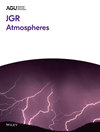Journal sub-heading titles: Journal of Geophysical Research (Atmospheres), Journal of Geophysical Research (Biogeosciences), Journal of Geophysical Research (Earth Surface), Journal of Geophysical Research (Oceans), Journal of Geophysical Research (Planets), Journal of Geophysical Research (Solid Earth), Journal of Geophysical Research (Space Physics). JGR-Atmospheres includes physics and chemistry of the atmosphere, as well as the atmospheric-biospheric, lithospheric, and hydrospheric interface. JGR-Biogeosciences focuses on biogeosciences of the Earth system in the past, present, and future and the extension of this research to planetary studies. The emerging field of biogeosciences spans the intellectual interface between biology and the geosciences and attempts to understand the functions of the Earth system across multiple spatial and temporal scales. Studies in biogeosciences may use multiple lines of evidence drawn from diverse fields to gain a holistic understanding of terrestrial, freshwater, and marine ecosystems and extreme environments. Specific topics within the scope of the section include process-based theoretical, experimental, and field studies of biogeochemistry, biogeophysics, atmosphere-, land-, and ocean-ecosystem interactions, biomineralization, life in extreme environments, astrobiology, microbial processes, geomicrobiology, and evolutionary geobiology. JGR-Earth Surface focuses on the physical, chemical, and biological processes that affect the form and function of the surface of the solid Earth over all temporal and spatial scales, including fluvial, eolian, and coastal sediment transport; hillslope mass movements; glacial and periglacial activity; weathering and pedogenesis; and surface manifestations of volcanism and tectonism. JGR-Oceans covers physical, biological, and chemical oceanography. JGR-Planets covers the geology, geophysics, geochemistry, atmospheres, biology, and dynamics of the planets, satellites, asteroids, rings, comets, and meteorites; planetary origins; and planetary detection. Studies of the Earth are included when they concern exogenic effects or the comparison of the Earth to other planets. JGR-Solid Earth focuses on the physics and chemistry of the solid Earth and the liquid core of the Earth, geomagnetism, paleomagnetism, marine geology/geophysics, chemistry and physics of minerals, rocks, volcanology, seismology, geodesy, gravity, and tectonophysics. JGR-Space Physics covers aeronomy and magnetospheric physics, planetary atmospheres and magnetospheres, interplanetary and external solar physics, cosmic rays, and heliospheric physics.
